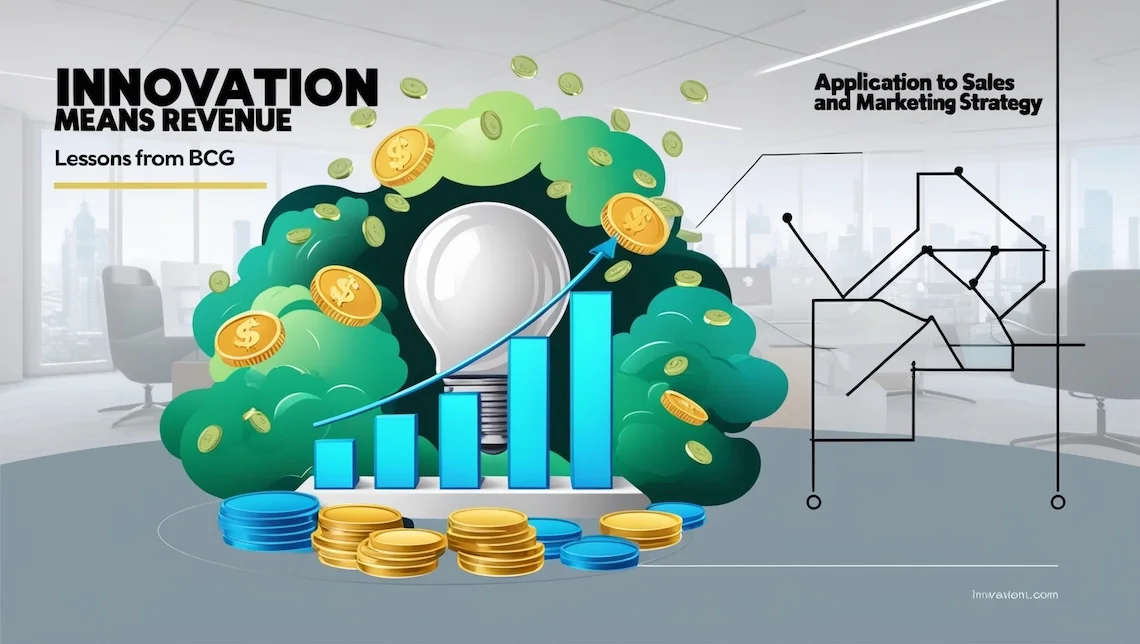

In today’s business environment, innovation is no longer a choice but a necessity.
It must be an integral part of organizations that aim to stay competitive, drive growth, and capture new market opportunities.
I’ve been thinking about the importance of innovation in driving revenue growth, especially in the context of sales and marketing strategy. Organizations prioritizing innovation tend to see higher revenue growth and long-term value creation. As a Sales and Marketing Action Manager, I am where strategy, execution, and innovation intersect to drive business success.
The 2023 Boston Consulting Group (BCG) Most Innovative Companies report emphasizes that innovation is increasingly central to most companies’ strategic objectives. In 2023, 79% of surveyed businesses listed innovation as one of their top three priorities, up from 75% in the previous year.
The report also highlights that companies effectively embedding innovation into their business models tend to outperform their competitors across critical financial metrics. According to BCG, the top 50 innovative companies generated shareholder returns of 3.3 percentage points higher annually than the broader market.
Companies that consistently innovate are better positioned than their peers to tap into emerging value pools, disrupt the market, and accelerate revenue growth.
As a Sales and Marketing Action Manager, I translate high-level innovation strategies into actionable initiatives directly impacting market share and revenue. BCG’s research offers valuable insights for aligning innovation with sales and marketing efforts.
BCG underscores the significance of ‘strategic foresight’—the ability to anticipate market shifts, new customer demands, and technological disruptions. This is particularly crucial for sales and marketing. By vigilantly monitoring market trends and understanding shifts in consumer preferences, I can steer your product development efforts towards areas with the highest growth potential. It also enables us to stay ahead of competitors by identifying emerging trends before they become mainstream.
For example, BCG has identified AI and automation as key drivers of innovation. We can improve efficiency and customer engagement by integrating AI into our marketing campaigns (for better personalization and predictive analytics) or using automation to streamline sales operations.
According to BCG, the most successful companies are those that innovate and efficiently turn that innovation into revenue-driving products. In my role, I focus on ensuring that product innovations are well-positioned in the market. This involves crafting clear messaging that highlights the unique value proposition of our offerings, identifying the right market segments, and ensuring that our sales teams are equipped with the knowledge and tools to communicate the benefits effectively.
For instance, a new feature in a product line may seem trivial internally, but it could be the differentiating factor that wins over a specific customer segment. By collaborating closely with the product development team and leveraging customer insights, I help ensure that innovations are strategically marketed to maximize revenue.
One key takeaway from the BCG report is the importance of agility in innovation. Successful companies are not just those that invest in R&D but those that can bring innovations to market quickly. In my day-to-day responsibilities, this translates into executing fast and flexible go-to-market strategies. Whether launching a new product or adjusting marketing campaigns in response to real-time customer data, agility ensures we capitalize on market opportunities faster than our competitors. This need for agility should make us feel alert and responsive in our execution.
BCG’s findings also underscore the importance of solving real customer problems. Successful innovation is more than just cutting-edge technology or novel products; it addresses unmet customer needs. By leveraging customer feedback and market research, I work closely with the development and marketing teams to ensure that innovations are designed with the customer at the centre. This enhances product-market fit and improves customer satisfaction, loyalty, and sales. This emphasis on customer-centric innovation should make us feel more empathetic and customer-focused.
One of the challenges highlighted in the BCG report is the «siloed» approach to innovation within many organizations. For innovation to drive revenue effectively, it must be a cross-functional effort. In my role, collaboration between sales, marketing, R&D, and customer service is critical. All teams must align on the innovation strategy and have a unified approach to positioning new products, communicating value, and driving adoption in the market.
The BCG report also highlights a key challenge: many companies lack the «innovation readiness» to leverage new opportunities fully. Only about 30% of surveyed companies reported having a clear innovation strategy. This highlights the importance of being deliberate and strategic in approaching innovation, especially in sales and marketing. Without a clear strategy, there is a risk of misaligned efforts, missed opportunities, and, ultimately, slower growth.
To close this gap, companies must ensure that innovation is not just about increasing activity or project numbers but also solving critical business challenges. Every marketing campaign or sales initiative must align with the company’s broader innovation strategy. By doing so, we can capture new market opportunities, drive revenue, and sustain long-term growth.
The insights from BCG’s Most Innovative Companies report provide valuable lessons on how innovation drives growth when strategically aligned with business objectives. For a Sales and Marketing Action Manager, this means ensuring that innovation is not just a buzzword but a core part of how we approach the market. Focusing on strategic foresight, customer-centricity, and cross-functional collaboration can turn innovation into a powerful revenue driver and competitive advantage.
In today’s business environment, innovation is no longer a choice but a necessity.
It must be an integral part of organizations that aim to stay competitive, drive growth, and capture new market opportunities.
I’ve been thinking about the importance of innovation in driving revenue growth, especially in the context of sales and marketing strategy. Organizations prioritizing innovation tend to see higher revenue growth and long-term value creation. As a Sales and Marketing Action Manager, I am where strategy, execution, and innovation intersect to drive business success.
The 2023 Boston Consulting Group (BCG) Most Innovative Companies report emphasizes that innovation is increasingly central to most companies’ strategic objectives. In 2023, 79% of surveyed businesses listed innovation as one of their top three priorities, up from 75% in the previous year.
The report also highlights that companies effectively embedding innovation into their business models tend to outperform their competitors across critical financial metrics. According to BCG, the top 50 innovative companies generated shareholder returns of 3.3 percentage points higher annually than the broader market.
Companies that consistently innovate are better positioned than their peers to tap into emerging value pools, disrupt the market, and accelerate revenue growth.
As a Sales and Marketing Action Manager, I translate high-level innovation strategies into actionable initiatives directly impacting market share and revenue. BCG’s research offers valuable insights for aligning innovation with sales and marketing efforts.
BCG underscores the significance of ‘strategic foresight’—the ability to anticipate market shifts, new customer demands, and technological disruptions. This is particularly crucial for sales and marketing. By vigilantly monitoring market trends and understanding shifts in consumer preferences, I can steer your product development efforts towards areas with the highest growth potential. It also enables us to stay ahead of competitors by identifying emerging trends before they become mainstream.
For example, BCG has identified AI and automation as key drivers of innovation. We can improve efficiency and customer engagement by integrating AI into our marketing campaigns (for better personalization and predictive analytics) or using automation to streamline sales operations.
According to BCG, the most successful companies are those that innovate and efficiently turn that innovation into revenue-driving products. In my role, I focus on ensuring that product innovations are well-positioned in the market. This involves crafting clear messaging that highlights the unique value proposition of our offerings, identifying the right market segments, and ensuring that our sales teams are equipped with the knowledge and tools to communicate the benefits effectively.
For instance, a new feature in a product line may seem trivial internally, but it could be the differentiating factor that wins over a specific customer segment. By collaborating closely with the product development team and leveraging customer insights, I help ensure that innovations are strategically marketed to maximize revenue.
One key takeaway from the BCG report is the importance of agility in innovation. Successful companies are not just those that invest in R&D but those that can bring innovations to market quickly. In my day-to-day responsibilities, this translates into executing fast and flexible go-to-market strategies. Whether launching a new product or adjusting marketing campaigns in response to real-time customer data, agility ensures we capitalize on market opportunities faster than our competitors. This need for agility should make us feel alert and responsive in our execution.
BCG’s findings also underscore the importance of solving real customer problems. Successful innovation is more than just cutting-edge technology or novel products; it addresses unmet customer needs. By leveraging customer feedback and market research, I work closely with the development and marketing teams to ensure that innovations are designed with the customer at the centre. This enhances product-market fit and improves customer satisfaction, loyalty, and sales. This emphasis on customer-centric innovation should make us feel more empathetic and customer-focused.
One of the challenges highlighted in the BCG report is the «siloed» approach to innovation within many organizations. For innovation to drive revenue effectively, it must be a cross-functional effort. In my role, collaboration between sales, marketing, R&D, and customer service is critical. All teams must align on the innovation strategy and have a unified approach to positioning new products, communicating value, and driving adoption in the market.
The BCG report also highlights a key challenge: many companies lack the «innovation readiness» to leverage new opportunities fully. Only about 30% of surveyed companies reported having a clear innovation strategy. This highlights the importance of being deliberate and strategic in approaching innovation, especially in sales and marketing. Without a clear strategy, there is a risk of misaligned efforts, missed opportunities, and, ultimately, slower growth.
To close this gap, companies must ensure that innovation is not just about increasing activity or project numbers but also solving critical business challenges. Every marketing campaign or sales initiative must align with the company’s broader innovation strategy. By doing so, we can capture new market opportunities, drive revenue, and sustain long-term growth.
The insights from BCG’s Most Innovative Companies report provide valuable lessons on how innovation drives growth when strategically aligned with business objectives. For a Sales and Marketing Action Manager, this means ensuring that innovation is not just a buzzword but a core part of how we approach the market. Focusing on strategic foresight, customer-centricity, and cross-functional collaboration can turn innovation into a powerful revenue driver and competitive advantage.



